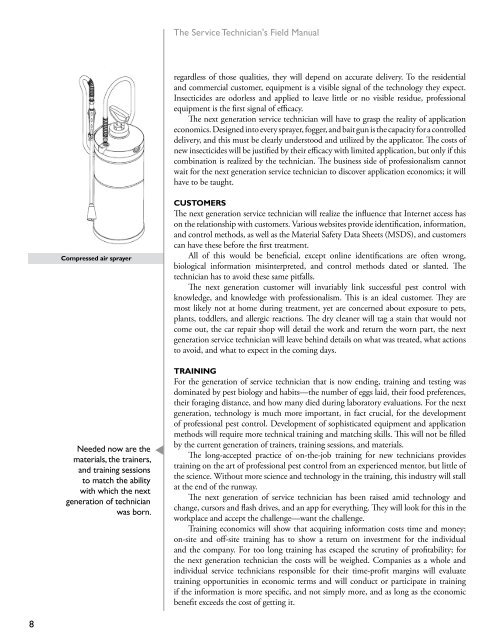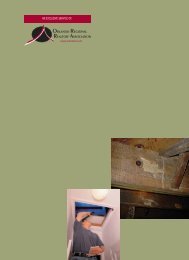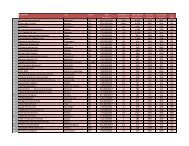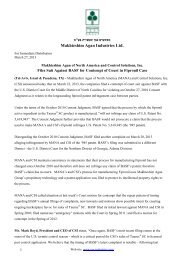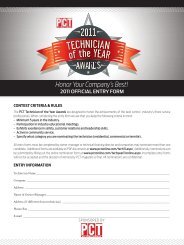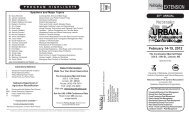table of contents - Pest Control Technology
table of contents - Pest Control Technology
table of contents - Pest Control Technology
You also want an ePaper? Increase the reach of your titles
YUMPU automatically turns print PDFs into web optimized ePapers that Google loves.
8<br />
Compressed air sprayer<br />
Needed now are the<br />
materials, the trainers,<br />
and training sessions<br />
to match the ability<br />
with which the next<br />
generation <strong>of</strong> technician<br />
was born.<br />
The Service Technician's Field Manual<br />
regardless <strong>of</strong> those qualities, they will depend on accurate delivery. To the residential<br />
and commercial customer, equipment is a visible signal <strong>of</strong> the technology they expect.<br />
Insecticides are odorless and applied to leave little or no visible residue, pr<strong>of</strong>essional<br />
equipment is the first signal <strong>of</strong> efficacy.<br />
The next generation service technician will have to grasp the reality <strong>of</strong> application<br />
economics. Designed into every sprayer, fogger, and bait gun is the capacity for a controlled<br />
delivery, and this must be clearly understood and utilized by the applicator. The costs <strong>of</strong><br />
new insecticides will be justified by their efficacy with limited application, but only if this<br />
combination is realized by the technician. The business side <strong>of</strong> pr<strong>of</strong>essionalism cannot<br />
wait for the next generation service technician to discover application economics; it will<br />
have to be taught.<br />
CuSTOmErS<br />
The next generation service technician will realize the influence that Internet access has<br />
on the relationship with customers. Various websites provide identification, information,<br />
and control methods, as well as the Material Safety Data Sheets (MSDS), and customers<br />
can have these before the first treatment.<br />
All <strong>of</strong> this would be beneficial, except online identifications are <strong>of</strong>ten wrong,<br />
biological information misinterpreted, and control methods dated or slanted. The<br />
technician has to avoid these same pitfalls.<br />
The next generation customer will invariably link successful pest control with<br />
knowledge, and knowledge with pr<strong>of</strong>essionalism. This is an ideal customer. They are<br />
most likely not at home during treatment, yet are concerned about exposure to pets,<br />
plants, toddlers, and allergic reactions. The dry cleaner will tag a stain that would not<br />
come out, the car repair shop will detail the work and return the worn part, the next<br />
generation service technician will leave behind details on what was treated, what actions<br />
to avoid, and what to expect in the coming days.<br />
TrAININg<br />
For the generation <strong>of</strong> service technician that is now ending, training and testing was<br />
dominated by pest biology and habits—the number <strong>of</strong> eggs laid, their food preferences,<br />
their foraging distance, and how many died during laboratory evaluations. For the next<br />
generation, technology is much more important, in fact crucial, for the development<br />
<strong>of</strong> pr<strong>of</strong>essional pest control. Development <strong>of</strong> sophisticated equipment and application<br />
methods will require more technical training and matching skills. This will not be filled<br />
by the current generation <strong>of</strong> trainers, training sessions, and materials.<br />
The long-accepted practice <strong>of</strong> on-the-job training for new technicians provides<br />
training on the art <strong>of</strong> pr<strong>of</strong>essional pest control from an experienced mentor, but little <strong>of</strong><br />
the science. Without more science and technology in the training, this industry will stall<br />
at the end <strong>of</strong> the runway.<br />
The next generation <strong>of</strong> service technician has been raised amid technology and<br />
change, cursors and flash drives, and an app for everything. They will look for this in the<br />
workplace and accept the challenge—want the challenge.<br />
Training economics will show that acquiring information costs time and money;<br />
on-site and <strong>of</strong>f-site training has to show a return on investment for the individual<br />
and the company. For too long training has escaped the scrutiny <strong>of</strong> pr<strong>of</strong>itability; for<br />
the next generation technician the costs will be weighed. Companies as a whole and<br />
individual service technicians responsible for their time-pr<strong>of</strong>it margins will evaluate<br />
training opportunities in economic terms and will conduct or participate in training<br />
if the information is more specific, and not simply more, and as long as the economic<br />
benefit exceeds the cost <strong>of</strong> getting it.


